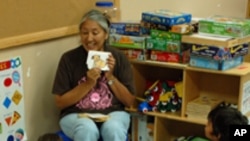<!-- IMAGE -->
Six young children - four girls and two boys - sit on the floor looking up at their teacher seated in a chair. An older woman with streaks of gray in the long, straight hair pulled back from her face, she holds up flashcards with colors and words spelled out in distinctive lettering. Her students are learning Cherokee, the language of their ancestors, but a language many of their own parents didn't speak as children.
A difficult language for adults to learn
"I'm still learning. I'm a second language learner," says Renissa Walker, who is in charge of the language, history and cultural preservation program for the Eastern Band of Cherokee Indians.
<!-- IMAGE -->
"It's a very, very difficult language. In Cherokee, there are so many verb tenses and tones and inflections." Cherokee also has a unique syllabary with 85 characters, each representing a syllable. It was created by a tribal member, Sequoyah, and adopted by the Cherokee in 1825.
Walker says, like many languages, Cherokee is not always easily translated. "There are appropriate ways of Cherokee living that are embedded into the language," she says. She fears those ways of Cherokee living are being lost, because the Cherokee don't use the language in everyday living.
Like Walker, Michell Hicks, principal chief of the Eastern Band of Cherokee Indians, is among those adults learning Cherokee. "My grandmother was fluent. My dad understands. He speaks some, but he only taught in bits and pieces, so that is how I learned." Chief Hick says he's still learning, and although he isn't fluent he does know quite a few phrases.
Chief Hicks has made language instruction a priority of his administration. The tribe estimates there are 300 fluent speakers among the population of 14,000. The majority are under five or over 50, like Renissa Walker's mother, Myrtle Driver.
The most important part of being Cherokee
<!-- IMAGE -->
"I think the most important part of being Cherokee is the language," Driver says. "When I speak my own language, I'm speaking from the heart. When I'm speaking English, from here." Driver brings her finger to her temple as she says this.
Driver was raised by her grandparents, who would not allow her to speak English in the home. Her daughter Renissa was raised by a white family. Driver says, at the time, it seemed the best choice for both her and her daughter, even though she wanted her to know about her Cherokee heritage.
"In order for me to go to school so I could provide for my children, I had to put her with a trustworthy foster home, and she liked it." Driver says her daughter, who moved back to the community as a teenager, had a far better education growing up with a white foster family.
But schools have improved on the reservation. A 1988 law gave American Indian tribes the authority to establish casinos on their lands. Some of the money that comes from the Eastern Band of Cherokee Indian's casino is funneled into education, including language classes.
Literature for future generations
<!-- IMAGE -->
When she thinks of the young children learning Cherokee today, Myrtle Driver is optimistic about the future of her tribe and its language. To ensure that generations to come would have literature to read in their language, she translated into Cherokee a portion of Charles Frasier's novel Thirteen Moons. It tells of the forced migration of the Cherokee people in 1838. Over 4,000 died on the journey. The Eastern Band of Cherokee Indians are descendants of those who remained behind, hidden in the Blue Ridge Mountains.
Although Frazier is white, Driver says, "He wrote it as if he experienced it." One day, she says, the young children learning Cherokee through immersion classes will read that account of the Trail of Tears, "and they will read it in the Cherokee way, as if grandma were sitting there telling them what actually happened."
They will read it with their hearts as well as their minds.





